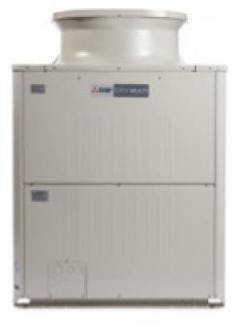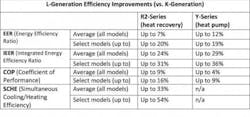Mitsubishi Introduces L-Generation Air Source
Mitsubishi Electric US, Inc. Cooling & Heating Division (Mitsubishi Electric) has introduced the latest innovation in Variable Refrigerant Flow (VRF) technology — the CITY MULTI® L-Generation Air Source outdoor units.
The L-Generation (6 to 30 tons; single modules up to 14 tons) has achieved significantly improved efficiency ratings due to , a zinc-aluminum flat tube heat exchanger that maximizes heat transfer capability through its unique fin shape. Increased efficiencies across all categories make this outdoor unit ideal for projects with efficiency goals such as LEED certification or net-zero status.
“The L-Generation, with its HexiCoil technology, represents a significant enhancement in efficiency and operation for the VRF category,” says Kevin Miskewicz, senior manager, commercial marketing, Mitsubishi Electric US, Inc. Cooling & Heating Division. “This coil redesign includes turbulated tube walls and an optimized cross section, ensuring maximum heat transfer ability. This advancement directly leads to improved efficiencies, particularly at part load conditions.”
The unique fin design of the HexiCoil product, along with its zinc outer coating, provides superior water shedding capability and corrosion resistance, prolonging the outdoor unit’s lifespan. The capillary tube system ensures even fluid distribution, further contributing to superior heat transfer ability.
Other L-Generation enhancements include:
- 30 percent smaller footprint than previous models, making the system ideal for projects with tight mechanical spaces.
- Up to 50 percent reduction in system refrigerant charge; refrigerant circuit design optimized for improved flow distribution.
- Improved high-ambient cooling operating range; guaranteed cooling operation up to 126 degrees Fahrenheit.
- Improved vertical separation between indoor units within the same heat recovery system – a distance of up to 98 feet – expanding design options.
The company reports these outdoor units are designed for the quietest possible operation — 58 to 65 dB(A). All models in the L-Generation now include a bellmouth grill with a DC fan motor, which reduces static pressure while minimizing power input.
Providing Solutions
VRF product innovations such as L-Generation, are well-timed, as they are in step with four key trends in the HVAC industry, which Kevin Miskewicz described during a recent Mitsubishi webinar presentation for comfort industry editors.
"The demand for energy efficient and mechanical equipment has been and continues to be a major trend within the industry," Miskewicz said. "With energy rates and other utility rates continually fluctuating, a building owner always looks to invest in efficient technology. Whether through government regulations, or through the desire to gain market share, the HVAC industry’s key players have been ratcheting up efficiency over the last few years.
"The demand for space-saving, flexible equipment has a direct correlation to the increasing demand for architecturally pleasing building designs. As building design becomes more increasingly focused on style versus the purely functional, there’s a demand for mechanical systems that are flexible enough to adapt, based on those designs," he said.
Miskewicz continued to say that the demand for personalization in comfort continues to become more prevalent in buildings today. This trend, which crosses many different platforms, has made its way into the HVAC industry over the last few years. Building occupants, who have become accustomed to living in the ‘information at your fingertips’ era, now seek ways to personalize their comfort within their individual occupied spaces, such as an office.
The fourth trend he described is a demand for better control over mechanical systems within a building, to more easily achieve individualized comfort.
"That control comes at two levels: centralized, and locally, within the space," he explained. "Centralized controllers can range from things like building automation systems that control all mechanical equipment in abuilding, to smaller controllers that control aspects of one mechanical system, such as the HVAC system. Controllers within that space provide occupants with the ability to personalize their comfort within that occupied space."
VRF, Miskewicz continued, answers these trends in the following ways:
• Energy efficiency: this is delivered through VRF systems through the use of inverter compressor technology. Inverter compressors modulate based on the amount of conditioning required in a zone or a building.
• Adaptability is achieved by the ability to connect indoor units to the outdoor unit through two refrigerant pipes, eliminating long runs of ductwork.
• The ability of VRF to provide personalized occupant comfort is "second to none," he said. By using indoor units and controllers within the spaces requiring conditioning, building occupants are empowered to control their own comfort.
• Lifecycle operating cost is optimized with VRF. Starting with a reduction in installation time and materials through the efficient operation of the equipment, and minimal maintenance requirements over the lifetime of that equipment, VRF provides a solution that lowers lifecycle operating cost.



